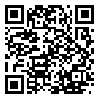Volume 14, Issue 1 (April 2007)
J Birjand Univ Med Sci. 2007, 14(1): 9-15 |
Back to browse issues page
1- Assistant Professor, Department of Health Education, Faculty of Public Health, Mashhad University of Medical Sciences. Mashhad, Iran , m-shidfar@mums.ac.ir.
2- Associate Professor, Department of Epidemiology and Biostatistics, Faculty of Public Health and Institute of Public Health Research, Teharn University of Medical Sciences. Tehran, Iran
3- Professor, Department of Health Services, Faculty of Public Health and Institute of Public Health Research, Teharn University of Medical Sciences. Tehran, Iran
4- Assistant Professor, Department of Epidemiology and Biostatistics, Faculty of Public Health and Institute of Public Health Research, Teharn University of Medical Sciences. Tehran, Iran
5- Associate Professor, Department of Health Services, Faculty of Public Health and Institute of Public Health Research, Teharn University of Medical Sciences. Tehran, Iran
6- Assistant Professor, Department of Cardiology, Islamic Azad University of Mashhad. Mashhad, Iran
2- Associate Professor, Department of Epidemiology and Biostatistics, Faculty of Public Health and Institute of Public Health Research, Teharn University of Medical Sciences. Tehran, Iran
3- Professor, Department of Health Services, Faculty of Public Health and Institute of Public Health Research, Teharn University of Medical Sciences. Tehran, Iran
4- Assistant Professor, Department of Epidemiology and Biostatistics, Faculty of Public Health and Institute of Public Health Research, Teharn University of Medical Sciences. Tehran, Iran
5- Associate Professor, Department of Health Services, Faculty of Public Health and Institute of Public Health Research, Teharn University of Medical Sciences. Tehran, Iran
6- Assistant Professor, Department of Cardiology, Islamic Azad University of Mashhad. Mashhad, Iran
Abstract: (22874 Views)
Background and Aim: Unstable angina (UA) patients are the majority of hospitalized patients in CCU exposed to high probability of recurrence. Most often re-hospitalization of these patients is due to lack of enough information and not obeying medical advice. The main objective of this study was to determine the impact of an educational intervention based on Health Belief Model on knowledge and attitudes of unstable angina patients in Mashhad university hospitals. Materials and Methods: An interventional study was conducted on 180 patients with unstable angina, consisting of 90 cases and 90 controls, who were hospitalized in the Heart Wards of two university hospitals in Mashhad. Randomly, the patients of one of these hospitals were selected as the case (intervention) and those in the second as control group (90 patients each). Professional physicians and nurses instructed the patients in the intervention group before and after discharge for two months. Data were obtained through a questionnaire before and after intervention in both groups. Then, the data were analyzed by SPSS (11.5) & STATA (8.0) software’s, using chi-square and ANCOVA tests. In all statistical analyses α=0.05 was taken as the significant level.
Results: The analysis of covariance (ANCOVA) showed that, compared with the subjects’ pre-intervention knowledge status score, there was a significant increase in the score of the intervention group (P<0.0001). The intervention resulted in improving the attitude status in the group (P<0.0001). But there was no significant increase in these variables in the control group.
Conclusion: It is possible to use nurses' capacities in improving heart patients' knowledge and attitudes. Thus, it is necessary that instructional service by nurses be offered under a well-planned program in order to improve the quality of life of heart patients.
Results: The analysis of covariance (ANCOVA) showed that, compared with the subjects’ pre-intervention knowledge status score, there was a significant increase in the score of the intervention group (P<0.0001). The intervention resulted in improving the attitude status in the group (P<0.0001). But there was no significant increase in these variables in the control group.
Conclusion: It is possible to use nurses' capacities in improving heart patients' knowledge and attitudes. Thus, it is necessary that instructional service by nurses be offered under a well-planned program in order to improve the quality of life of heart patients.
Type of Study: Original Article |
Subject:
Health Education
Received: 2006/09/6 | Accepted: 2016/03/10 | ePublished: 2016/03/10
Received: 2006/09/6 | Accepted: 2016/03/10 | ePublished: 2016/03/10
| Rights and permissions | |
 |
This work is licensed under a Creative Commons Attribution-NonCommercial 4.0 International License. |
